Can I Get My Phaelenopsis to Bloom Again
Did you know that there are over 25,000 — peradventure even 30,000 — orchid species — and that about one in x flowering plants in the earth is an orchid? That the flavoring vanilla is an orchid?
Or that orchids occur naturally on every continent except Antarctica, although most normally bachelor orchids originated in tropical and subtropical regions? And that they range from microscopic to plate-size?
Growing up in the mid-Atlantic region, I rarely encountered anyone who cultivated orchids, but I was certain that they were difficult to grow, requiring a greenhouse and an extremely green pollex.
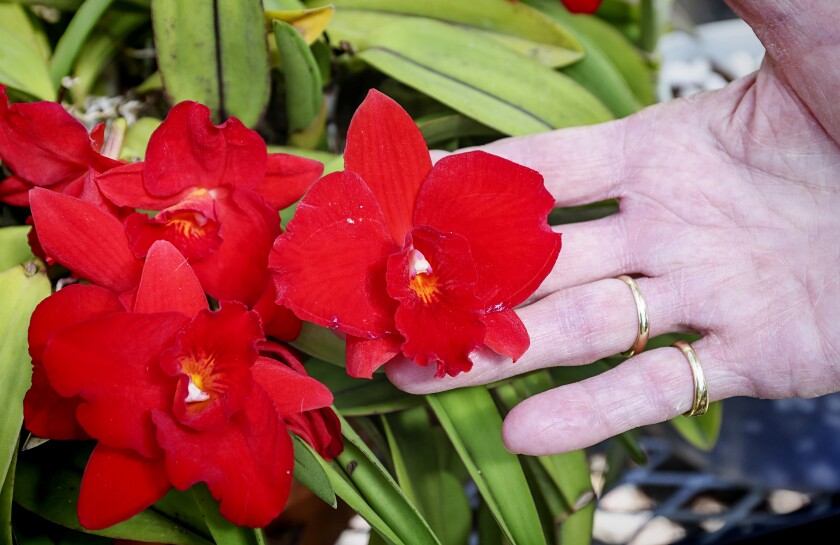
A compact Cattleya orchid called Slc. Circle Star offers vibrant color in the shade house at Debby Halliday's home.
(Eduardo Contreras / The San Diego Union-Tribune)
None of that complexity, fortunately, is true. While some exercise require special handling, the vast majority of orchids are easy to grow, specially in our San Diego climate. As long equally y'all understand bones orchid care, you can grow them happily both indoors and outdoors in your shaded yard, on your patio or balcony.
Recently, I visited the orchid collection and greenhouse of Debby Halliday, president of the San Diego Canton Orchid Society (SDCOS), who nurtures her collection of 700 to 750 orchids at her Rancho Santa Fe home. Different many orchid club members who specialize in specific types or varieties of orchids, Halliday favors variety.
"The matter I similar most about orchids is how different they are. I'one thousand non a specialist at all. I'thousand a specialist in how many types of orchids I can grow," she explained. "They're extremely varied — that'south the fun of orchids."
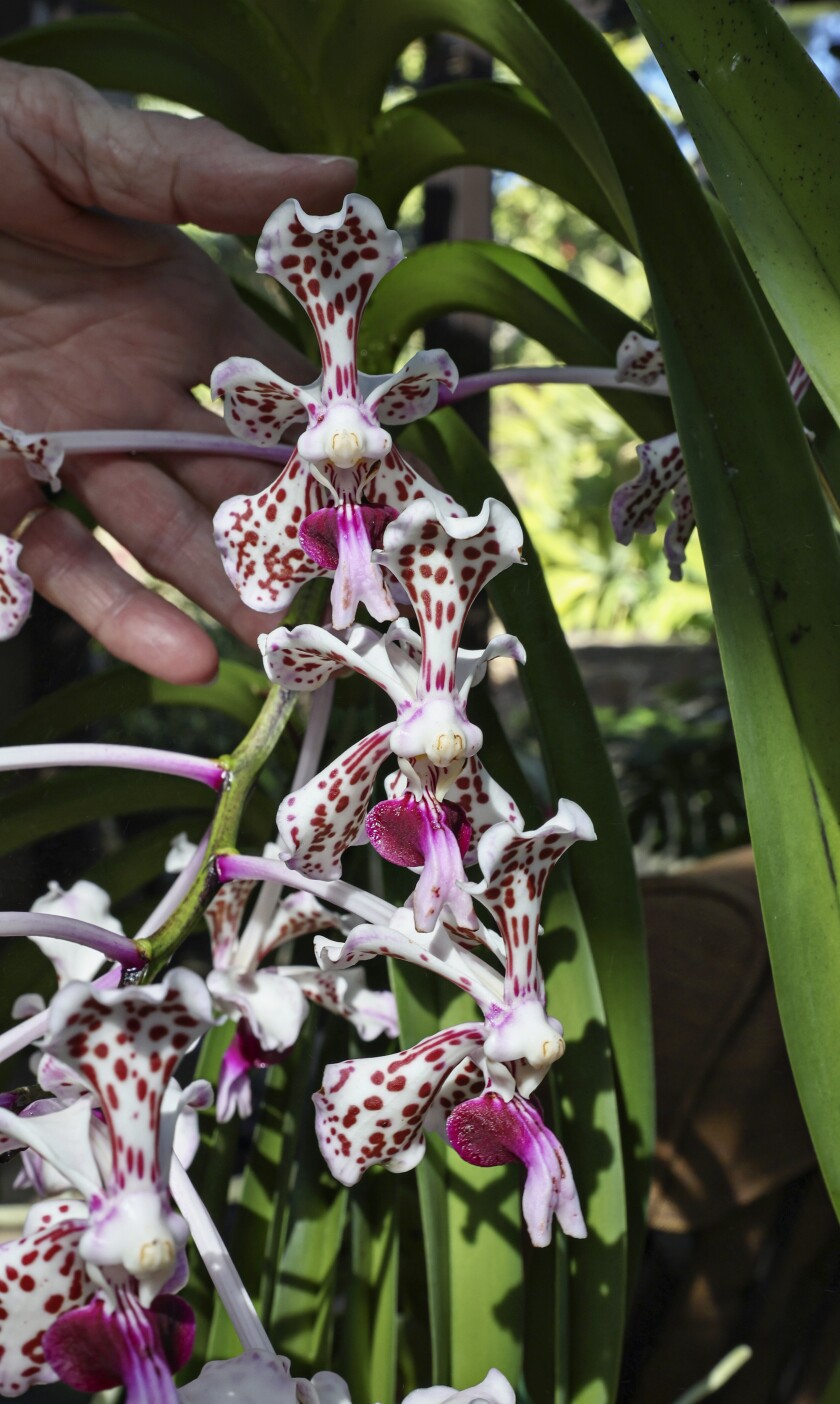
The orchid called Vanda tricolor, growing in Halliday'south greenhouse. This very fragrant species, native to Bali and Java, favors more sunlight.
(Eduardo Contreras / The San Diego Union-Tribune)
During my visit, she introduced me to the many vibrant varieties she grows and explained their tillage and handling.
Her drove emphasizes year-round blooms. The best way to ensure having consistent flowers, she explained, is to buy plants in flower, preferably at orchid shows, then you understand their flowering cycle. Some flower but once a year, simply others bloom several times annually.
Orchids come in widely ranging colors and sizes, from whites, pinks, purples and reds to yellows, greens and blues. Many are fragrant, others are not, and that fragrance is mostly linked to the time of twenty-four hour period orchids await visits from pollinators, since they crave exterior help with pollination.
"They more often than not have a smell schedule, for example, from ix a.m. to 1 p.m. or at dusk, when the moths are out," Halliday explained, although she pointed out that some produce odour all day.
Orchids and their pollinators evolved in tandem. She pointed out her Darwin'due south star orchid, which has an unusually long spur or nectar tube. When Charles Darwin received a sample in 1862, he noted its pollinating insect must have an unusually long proboscis to drink its nectar and transfer pollen. Despite contemporaries' scoffing, Darwin was proved correct when the orchid'southward pollinator, the hawk moth, was discovered decades later in Republic of madagascar, the orchid's native habitat.
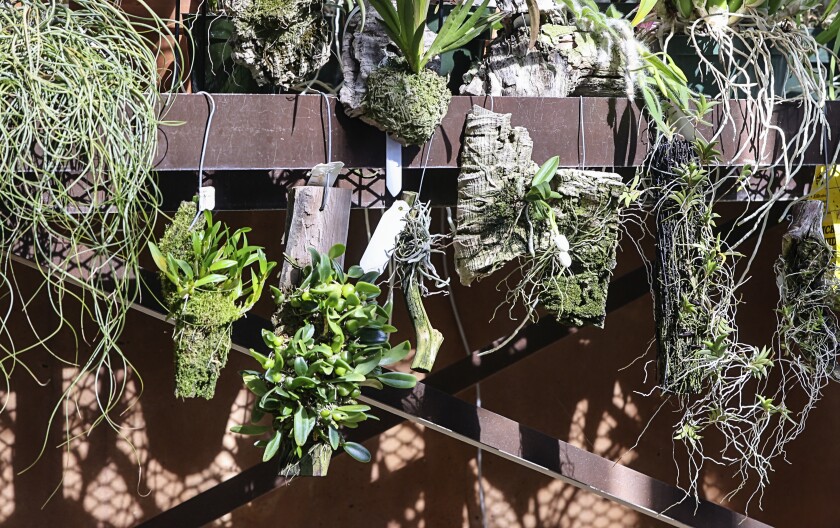
A diverseness of mounted orchids grow attached to slabs of woods that tin be hung. The setup offers a natural display alternative to pots.
(Eduardo Contreras / The San Diego Marriage-Tribune)
While some varieties, such as Sobralias and Epidendrums, are considered terrestrial and grow well in the basis, about varieties are epiphytic, which ways they grow naturally on trees or other plants.
Cymbidiums are one variety of popularly sold orchids that tin abound in the basis, merely just with excellent drainage and the right mix of dappled shade and limited water. Like nigh other orchids, they are more likely to thrive if kept in pots in an appropriate orchid bark mix.
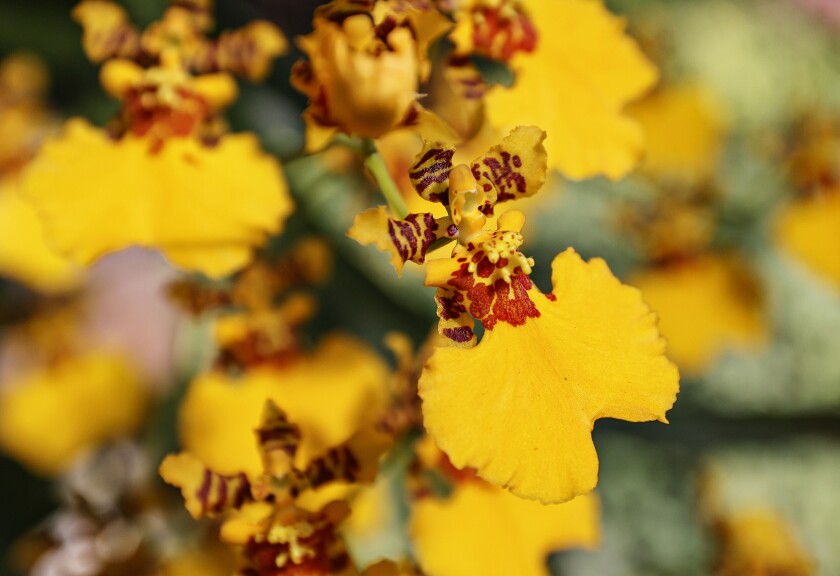
The common name for this hybrid Oncidium orchid growing in Halliday's shade business firm is Dancing Ladies — an understandable moniker given the skirtlike bloom.
(Eduardo Contreras / The San Diego Union-Tribune)
San Diego, Halliday continued, is an platonic climate for growing orchids outside. She recommends keeping them in containers, which can be moved around to find the correct mix of lord's day and shade, mimicking how they abound in trees in their native habitats.
Phaelenopsis, one of the most commonly sold orchids, for instance, grows lower in the copse and receives more shade, while Cattleyas grow higher in the trees and crave more than sunlight. Just well-nigh orchids do well in "dappled" shade, similar to sunlight filtering through the tree canopy.
If yous don't have an appropriately shaded surface area at your dwelling, whether in your garden, patio or balcony, you tin can easily create an awning or screen providing shade using woven or knitted shade fabric, which is sold by the percentage of light it blocks. Generally, shade cloth rated at 75 to 80 pct is a good option for orchids, though some varieties, such as Cattleyas, Dendrobiums and Oncidiums, like more low-cal and would practice ameliorate with 50 per centum shade cloth.
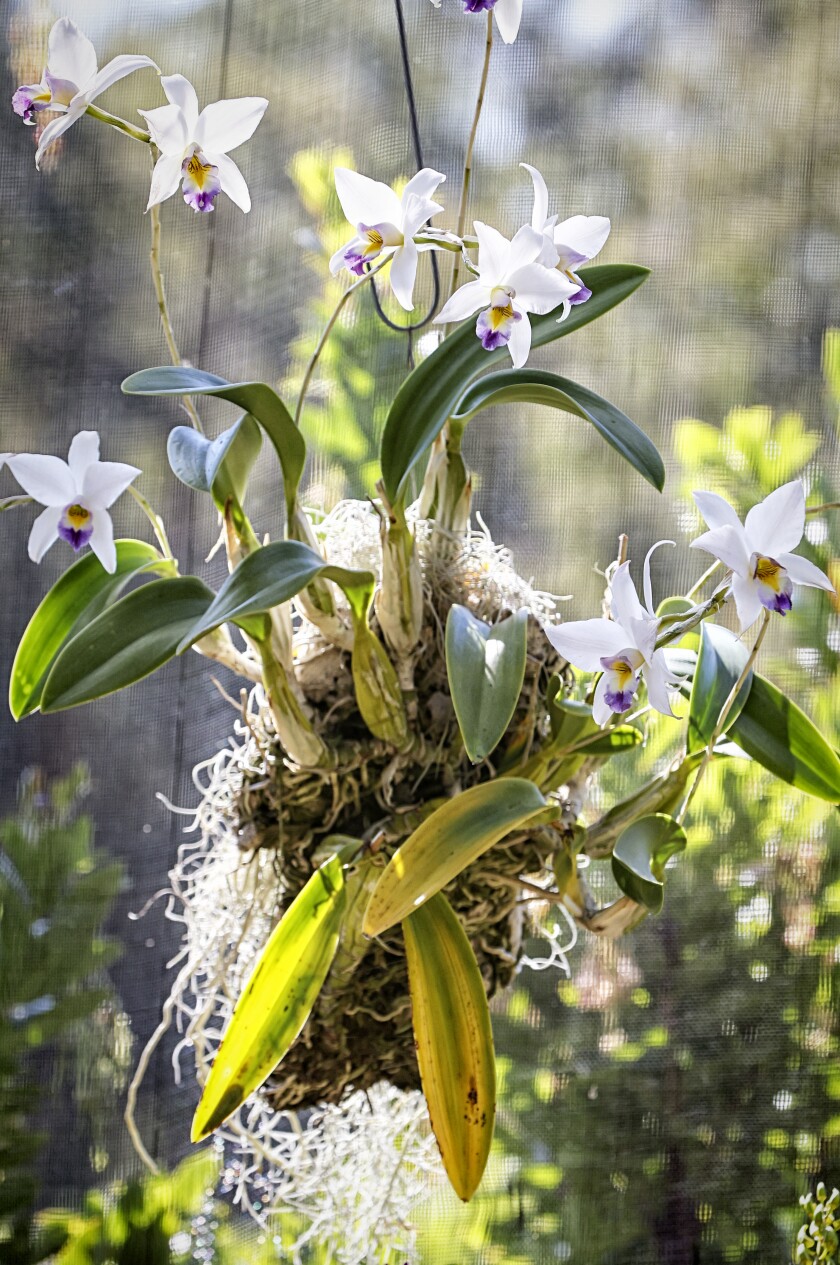
The orchid species orchid Laelia anceps hangs gracefully in the shade house.
(Eduardo Contreras / The San Diego Union-Tribune)
"Recollect nigh how orchids grow (in their native habitat): They abound in trees. They accept roots that wrap effectually trees," Halliday explained. "It rains hard in the torrid zone and and then it stops and the roots dry out out. Then they're soaked again. That'due south how they desire to be shaded and watered, with the rain washing grunge and nutrients off the copse, providing orchids food. That's why we say water 'weakly weekly,' with quarter strength fertilizer once a week," using a counterbalanced fertilizer of 10-10-10 or 20-20-20.
The best way to kill orchids is to overwater them. (It'due south not unusual for even experienced growers to kill a few.) It's best to allow them dry out out between waterings. They demand a wet-dry cycle to survive and thrive.
"When it's nearly dry, water well. Put the plant in the sink and, after watering, let it drain thoroughly," she said.
"Beneficial fail," letting orchids dry, is preferable to overwatering, she said, but not to the point they become desiccated.
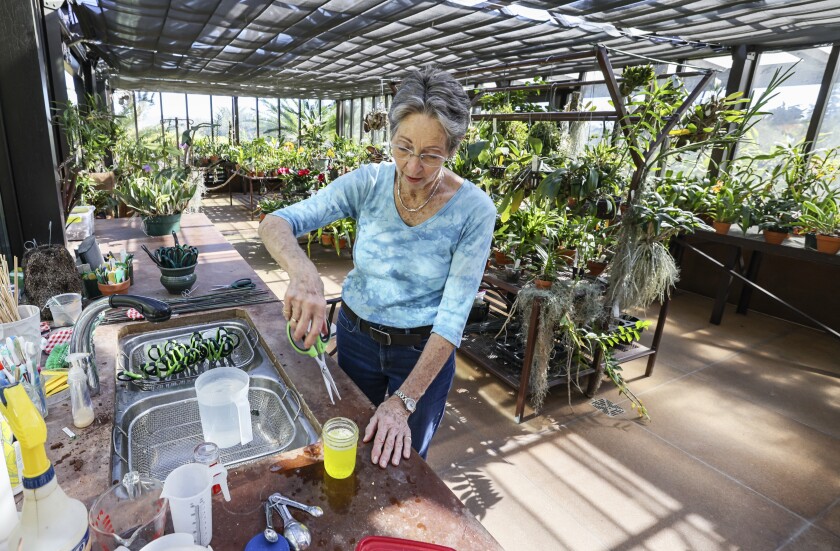
Halliday uses a ii-step process to sanitize the collection of scissors used to trim her orchids, to forbid the spread of infestations and viruses.
(Eduardo Contreras / The San Diego Spousal relationship-Tribune)
While orchids grow well in the moss that many are sold in, the medium is more probable to turn to unhealthy mush than bark, which is ameliorate for orchids because of its superior drainage. It's best to repot plants when the growing medium deteriorates or when they start "walking out of the pot," she said.
Only outside her greenhouse, in a shaded outdoor area, Halliday has several treelike posts where Oncidiums, mounted commencement on cork and so hung on the post, take wrapped their roots around the mail service and put out an abundance of spikes with flowers, where, she explained, they've never been happier.
Similarly, on a trip to Rio de Janeiro, SDCOS fellow member Peter Tobias observed that some Rio street trees were the aforementioned as San Diego's, merely were covered in orchids.
"In Rio, they purchase orchids in grocery stores," said Tobias, who has a drove of about 250 natural-species orchids at his Encinitas home. "When they finish blooming, they put them in the crotch of copse and they naturalize," he said.

A Darwin's star orchid, with an unusually long nectar tube, is pollinated by the hawk moth, with an equally long mouthpart.
(Eduardo Contreras / The San Diego Spousal relationship-Tribune)
He decided to try that with his two mature avocado trees, which are now covered in brilliantly colored naturalized orchids.
"Orchids are piece of cake to grow if you get an orchid that'southward right for the climate, the right temperature and light conditions you have," he said.
Halliday explained, "A lot of growing orchids is just trial and error, paying attending. I look for growth, bugs, scale and mealybugs."
She emphasized the importance of sanitation to prevent spreading infestations and incurable viruses between plants. That's why she e'er sanitizes her multiple pairs of scissors betwixt apply on individual plants with a 10-minute dip in a saturated solution of trisodium phosphate (TSP, available at Home Depot): three parts water to ane role TSP. Afterward, she rinses her pair of scissors and dips them in a two percent solution of Virkon S (bachelor online) and lets them dry.

Paph. villosum — commonly, Slipper Orchid — is noted for its sleeky flower.
(Eduardo Contreras / The San Diego Wedlock-Tribune)
Where tin can you buy adept orchids? Trader Joe's and other markets, as well as almost nurseries, do a expert job with standard diversity orchids, Halliday said, offering healthy plants — but avoid the bargain table, she warned.
"You want plants with almost half their flowers open, with leaves that are shiny and crispy like fresh lettuce and experience thick. The roots should be shiny, white and firm," she explained.
For more unusual varieties, she recommends San Diego County commercial growers Cal-Pacific Orchids, Andy's Orchids, Sunset Valley Orchids, and Casa de la Orquídeas. Most crave an appointment to visit.
Betty Kelepecz has a collection of about ane,000 orchids that are focused on Andean deject forest varieties compatible with the marine layer often cloaking her Signal Hill abode. Orchids, she insists, are not hard to grow.
"I was a proficient grower before, just I'grand an exponentially ameliorate grower because I'chiliad around others who taught me so much virtually how to grow orchids. You lot'll gain confidence and growing success," she said.
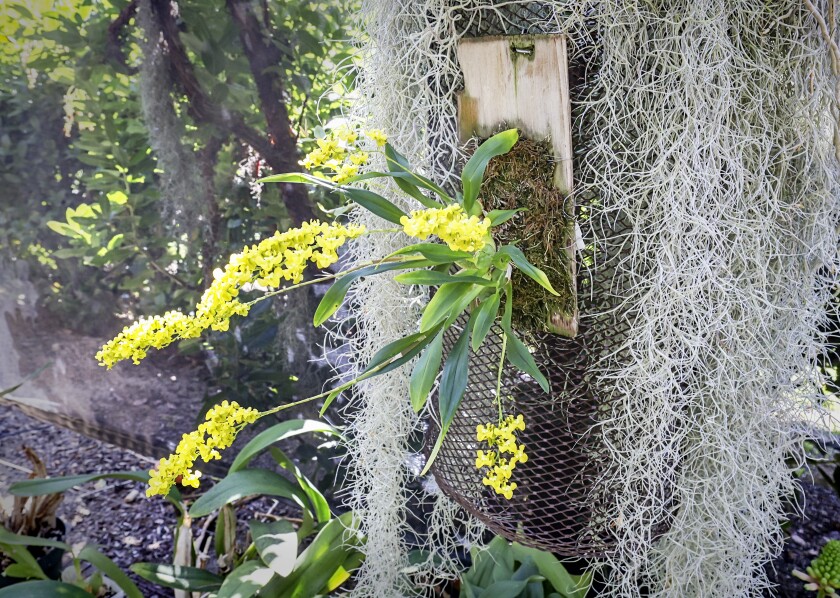
A mounted Oncidium, bearing the common proper name Colombian Buttercup. Orchids growing on copse in their native habitat draw nutrients washed down by pelting.
(Eduardo Contreras / The San Diego Wedlock-Tribune)
Join the local growing community
If you'd similar to acquire more than most growing orchids, check out these two local organizations. Run into their websites for upcoming speakers and details.
San Diego County Orchid Society: sdorchids.com, $20 a year for individual membership, $25 for dual membership. The SDCOS meets monthly in Balboa Park at the Casa de Balboa, besides equally on Zoom.
Palomar Orchid Order: palomarorchid.org, $25 a year for individual membership, $thirty for household. This North County group, based in Carlsbad, meets monthly at the Carlsbad Metropolis Library.
Sours Larson is a San Diego freelance writer.
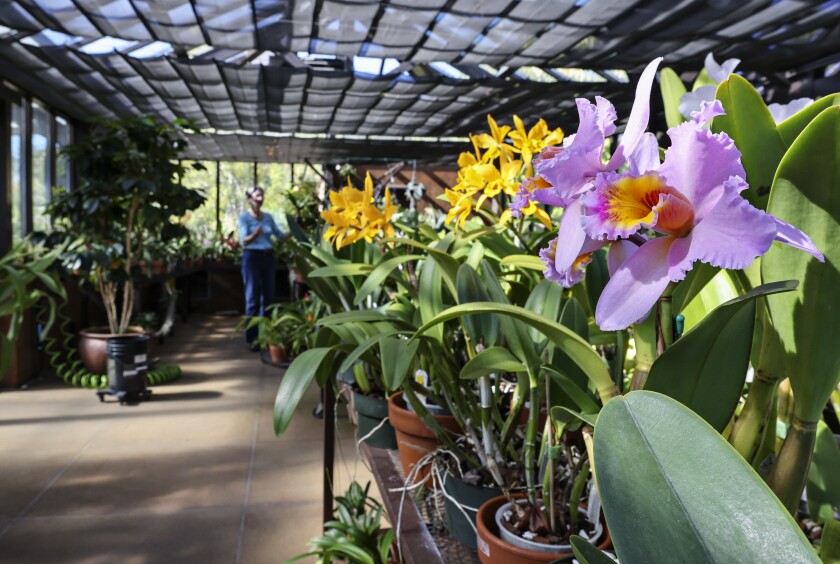
Full-size Cattleya orchid hybrids grow in the light-green house.
(Eduardo Contreras / The San Diego Union-Tribune)
Source: https://www.sandiegouniontribune.com/lifestyle/home-and-garden/story/2022-03-12/orchids-gift-is-two-fold-easy-care-abundant-beauty
0 Response to "Can I Get My Phaelenopsis to Bloom Again"
Post a Comment